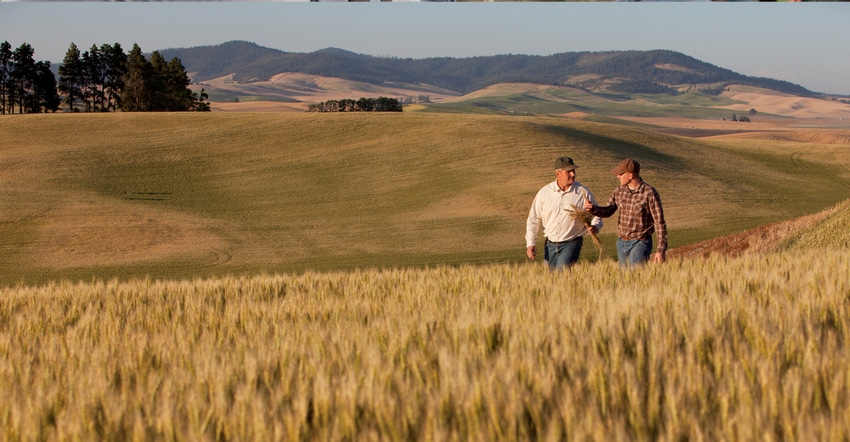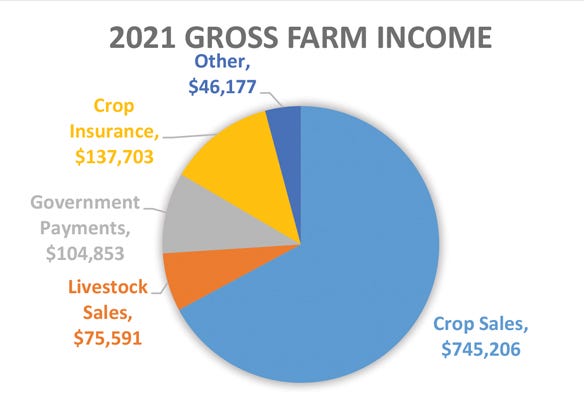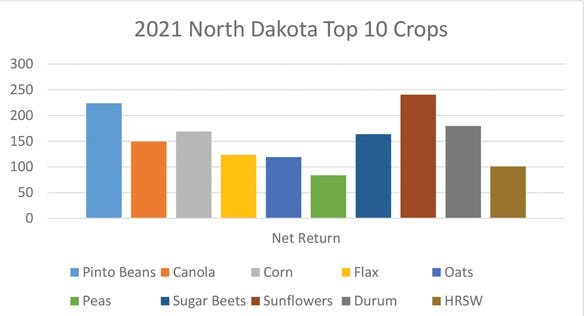June 21, 2022

Financially, 2021 was a strong year for North Dakota producers. The average net farm income for 2021 was $408,835, which was an increase from $176,038 in 2020. This was largely due to higher commodity prices, crop insurance and government payments that were available to producers.
In 2021, the average farm enrolled in the North Dakota Farm Management Education Program had 2,228 crop acres and grazed 427 pasture acres. The average operator was 48 years old and had 23 years of farming experience.
2021’s gross cash farm income was just over $1.1 million, of which 67% was from crop sales, 12% from insurance indemnities, 9% from government payments and 7% from livestock sales as shown in Table 1 below. Crop sales increased about $130,000, and livestock sales decreased about $3,900 in comparison to 2020. Government payments decreased about $50,000, and insurance payments increased about $38,500 from 2020.

The average total cash farm expense was $796,100, increasing $48,526 from the average total cash expense in 2020. Due to the increase in expenses, there was also an increase in the amount of borrowed money and, therefore, more debt being paid down in 2021. For that reason, the average debt-to-asset ratio dropped from 31% in 2020 to 29% in 2021.
North Dakota producers saw an increase in profitability measures in 2021. The rate of return on assets increased to 13.1% from 5.9% in 2020, and the rate of return on equity increased to 18.8% from 7.1% in 2020, indicating that borrowed money is making returns to operations. In addition, the 2021 average term debt coverage ratio was 4.54, meaning farmers and ranchers produced enough income to cover intermediate and long-term debt payments four and half times.
In 2021, the average operating expense ratio was 57.8% and the average interest expense ratio was 3.1%. This means that every dollar a producer earned in 2021, 58 cents was spent on operating expenses and 3 cents on interest. Of that dollar, 7 cents was also allocated to depreciation. This leaves about 32 cents of that dollar as profit.
Crop yields decreased from 2020 yields statewide, primarily due to the widespread drought. Sugarbeets on cash-rented land was the only crop that saw an increase in crop yield. 2021’s five most profitable crops grown on cash-rented land in North Dakota are:
sunflowers with a net return of $240.35 and yield of 16.92 cwt per acre
pinto beans with a net return of $223.78 and yield of 5.61 cwt per acre
durum with a net return of $179.55 and yield of 26.83 bushels per acre
corn with a net return of $168.93 and yield of 118.20 bushels per acre
sugarbeets with a net return of $163.70 and yield of 29.31 tons per acre
The top 10 crops produced in North Dakota during 2021 are outlined in Table 2 below, showing the average net return for each crop.

In 2021, North Dakota cattle producers saw an increase in beef cow-calf profits. Although feed costs were up, beef producers had an increased gross margin due to government payments (Livestock Forage Payment and Coronavirus Food Assistance Program 3), an increase in culls sales, and increased calf prices.
The average net return in 2021 was $102.12 per cow, which is an increase of $70.67 per cow from 2020. The average weaning weight was 496 pounds, and the average weight of calves sold was 403 pounds, with an average sale price of $208.22 per cwt.
The 2021 beef backgrounding enterprise showed an average net return of $90.94 per head, which was greater than the 2020 average net return of $20.06 per head. On average, backgrounders sold weighing 717 pounds at $139.55 per cwt, which equates to an average of $1,000.57 per head.
Overall, producers enrolled in the 2021 North Dakota Farm Management Education Program did very well despite statewide drought conditions. Crop producers experienced lower yields but higher commodity prices, while beef producers experienced higher cattle prices, which helped offset higher feed costs.
The data within this article was gathered by 11 North Dakota Farm Management Education programs. Instructors were able to gather information from 304 producers in different regions throughout the state. If you’d like to see your region’s annual report or the full state average report, contact your local North Dakota Farm Management Education instructor or visit ndfarmmanagement.com.
Aberle is an instructor with the North Dakota Farm Management Education Program. To learn more about farm succession planning and other financial questions, visit with an instructor near you. The program provides learning opportunities in economic and financial management for persons involved in agriculture. Visit ndfarmmanagement.com, or contact Craig Kleven, state supervisor for agricultural education, at [email protected] for more information.
You May Also Like




